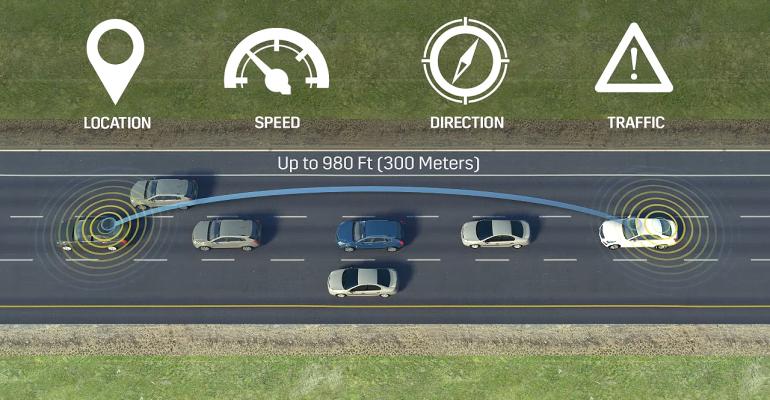Automakers and regulators know the best safety technology for cars has been sitting on the shelf for years. And yet they’ve largely ignored it. For the life of me, I can’t figure out why, since it could save thousands of lives a year.
I’m talking about V2V, or vehicle-to-vehicle communication, and it should have been on cars a decade ago. Or at least five years ago. But as it stands, I’m not sure when it will be available. It always seems to be just “a couple of years away.”
Let me tell you the story of how I learned about this technology. It goes back 20 years to a demonstration that General Motors invited me to. We were on a massive paved test facility. I slid behind the wheel of a Cadillac CTS while a GM engineer jumped into the passenger seat.
“See that car out there?” he said, pointing to another CTS parked several hundred yards away on the pavement. “I want you to start this one up and try to drive right into it.”
“Sure,” I chuckled. I buckled up, started the engine, put the car in Drive and headed straight toward the other CTS.
“C’mon, go faster,” he complained, “Get it up to at least 50 or 60 miles an hour.” Which I did.
A moment later a flashing light popped up on top of the instrument cluster, with a beep-beep-beep alarm filling the cabin.
“What’s that for?” I asked.
“That’s to make you look ahead and see that there’s an obstacle that you should avoid. But keep aiming at that car and don’t lift.” I pressed down harder on the gas pedal.
Next, the front of my seat started vibrating vigorously.
“What’s that for? I exclaimed.
“That’s warning that a collision is imminently in front of you,” he said. “But don’t lift and aim right at that car.” Which I did.
And then, all of a sudden, my CTS started slowing. The car was braking, even though my right foot was firmly planted on the gas pedal and I hadn’t touched the brakes.
“Don’t lift,” he said. I didn’t.
And then, pretty as you please, the CTS I was driving came to a stop about a foot or two away from the parked CTS. Otherwise, I would have t-boned it going 60.
And that’s how V2V works. It’s wireless communication that allows cars to “talk” to each other and when it realizes there’s going to be an accident, it hits the brakes. Or accelerates to get out of the way. V2V can make it almost impossible for cars to crash into each other. And because it’s wireless it can “see” around corners. So even if someone was, say, running a red light, V2V would prevent cars from crashing at the intersection.
Safety experts have found that most people don’t brake hard enough, even when it’s obvious they’re going to crash. People are neither trained to, nor are comfortable with, slamming on the brakes. That’s not a problem with V2V.
The demo I got from GM was sometime around 2004. When I asked the engineers when V2V could be production-ready, they said it should be available around 2012. A bankruptcy and a Great Recession may have delayed those plans, but Cadillac did start installing V2V in Cadillac CTS models in 2017. But it dropped it when the CT5 replaced the CTS.
Part of the reason why it’s still not in cars is that GM’s V2V relied on DSRC, or dedicated short-range communication, which is a Wi-Fi protocol. And there was a big fight in Congress between the auto industry and the telcos, who wanted that spectrum for their own telecommunication needs. The auto industry actually got Congress to carve out a part of the spectrum they wanted, but by the time they got it, 5G tech was becoming available and suddenly the auto industry decided 5G would be better than DSRC.
And so, we’ve seen demos of V2V using cellular 5G, referred to as C-V2X, or cellular vehicle-to-infrastructure. And it works swell. But nothing is in production. It’s still “several years away.”
In 2016 NHTSA proposed a rule to mandate V2V, but the White House axed it the following year. Something about too many regulations.
And so, we’ve wasted years discussing other picayune safety measures that have nowhere near the life-saving potential of V2V. The National Transportation Safety Board is asking for speed warnings in cars to let drivers know when they’re going over the speed limit. The Insurance Institute for Highway Safety is asking for better seat belts for back seat passengers. NHTSA is asking for stronger seats.
 Well, I think I’ve got a better idea. How about mandating the technology that will prevent cars from ever colliding in the first place? Wouldn’t that be better than all those other ideas put together? You bet it would. It would be the biggest step forward in automotive safety – ever. Better than seatbelts and airbags.
Well, I think I’ve got a better idea. How about mandating the technology that will prevent cars from ever colliding in the first place? Wouldn’t that be better than all those other ideas put together? You bet it would. It would be the biggest step forward in automotive safety – ever. Better than seatbelts and airbags.
I hope someone in a position of power picks up the cause and makes a run with it. They’ll be hailed as a hero if they can make it happen. But they’d better be ready for a battle with the bureaucracy. It takes NHTSA almost seven years to write a new safety regulation, which to my mind is beyond comprehension. And maybe I’ll save that complaint for a future column.
John McElroy (pictured, above left) is the president of Blue Sky Productions, which produces “Autoline Daily” and “Autoline After Hours” on www.Autoline.tv and the Autoline Network on YouTube. The podcast “The Industry” is available on most podcast platforms.





